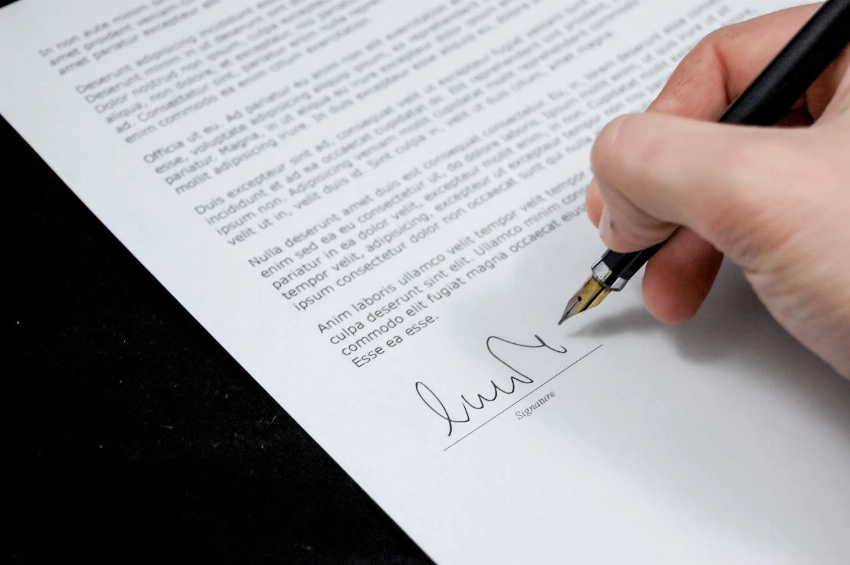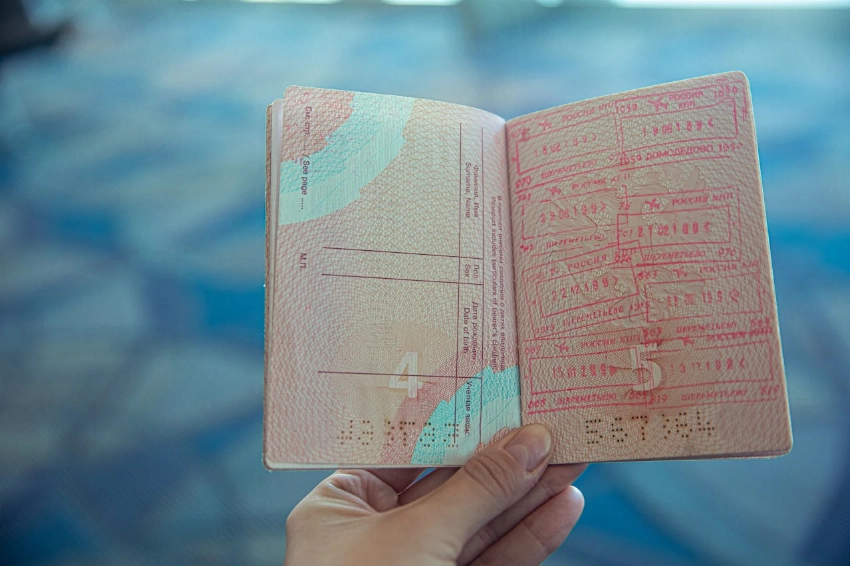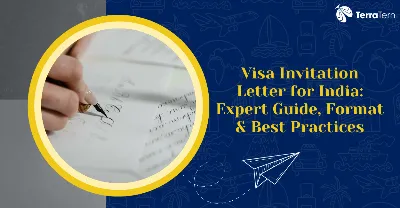Key Highlights
- Knowing about Visa Invitation Letter India: All the Tricks and Secrets
- Role in Visa Application Process
- Types of Invitation Letters for Indian Visa Applications
- Essential Components of a Valid Visa Invitation Letter India
- Invitation Letter for Business Visa India Format – Step-by-Step Guide
- How to Write an Effective Visa Invitation Letter for India?
- Common Mistakes and How to Avoid Visa Rejection
- Supporting Documents and Attachments
- Country-Specific Requirements and Variations
- Digital Age Considerations and E-Visa Integration
- Processing Times and Status Tracking
- Legal Compliance and Immigration Law Updates
- Professional Services and Expert Assistance
- Conclusion
When it comes to the theoretical preparation of an international trip, the process can be very stressful at times and especially when one intends to visit India, a properly prepared visa invitation letter for India can form a foundation stone of an effective visa application. By 2025, as the rules are likely to change and become more deeply ingrained in the digital world, it is high time to get the specifics of these documents. The chosen topic will discuss a general overview of the visa invitation letter for India, its legal status, the different varieties of it, as well as the crucial parts of a visa invitation letter for India and the ideal way of drafting a visa invitation letter for India.
Knowing about Visa Invitation Letter India: All the Tricks and Secrets

India visa invitation letter for India is an official statement issued by a host in India, who confirms his /her readiness to accommodate a foreign national in India. It is an extremely important Indian visa documentation that gives it indispensable visa support documents, which form the basis of the authenticity of the applicant's visit and sort out immigration issues. These letters provide an additional level of validation and can be in the form of financial security, which helps the visa officer in processing their own dealings. The basic difference between them is that they are not self-declarations, which are usually self-paid trips that do not have a particular host.
Legal Definition and Purpose
According to the Indian immigration regulations, a visa invitation letter for India is an official document that confirms the reason why a foreign national is coming to India. In case of visa evaluation, its main role is to convey the truth in the intention of the visitor, establish the connections with a sponsor in India, and reassure immigration officers that the visitor will not overstay his or her visa, as well as secure that the visitor is not going to take part in any illegal undertaking. It helps the applicant secure his or her application by offering a locally known reference, which would tend to eradicate perceived hazards of the applicant by what the visa officers may have lacked financially and accommodation-wise. Voice search optimised, such as common searches like, what are the legal requirements in order to invite someone to India in terms of an invitation letter? This definition touches on the points raised by them directly.
Role in Visa Application Process
The visa invitation letter for India can fit easily into the routine process of applying for a visa. It is, however, an obligatory accompaniment document once drafted and signed over by the host and should be provided with the applicant and his or her application form, passport photographs, and any other pertinent documentation. Early in the process, it is also common that the consulate or embassy will review it to determine the bona fides of the visit. A full, complete, and accurate visa invitation letter for India will ensure a smooth flow as far as visa issuance is concerned, right through the process of application submission to final approval.
Also Read: Invitation Letter for Business Visa: Key Tips & Guide
Difference Between Self-Declaration and Invitation Letters
Understanding the distinction between self-declaration and visa invitation letter for India is crucial for a successful application.
|
Feature |
Self-Declaration |
Invitation Letter |
|
Purpose |
Applicant declares intent for self-funded travel |
The host invites and takes responsibility for the visitor |
|
Funding |
Applicant covers all expenses |
The host may cover or share expenses |
|
Host Required? |
No |
Yes |
|
Scenarios |
Independent tourism, individual exploration |
Family visits, business meetings, conferences, and medical treatment |
|
Documentation |
Proof of personal funds, itinerary |
Host details, relationship proof, and financial guarantees |
Self-funded applications typically involve a self-declaration outlining the applicant's financial capability and travel itinerary. In contrast, a visa invitation letter for India explicitly states a host's willingness to host, often implying some form of support or responsibility, making it essential for specific visa categories.
Types of Invitation Letters for Indian Visa Applications

There is a great variety of visa types in India, and different types of visas may require different types of visa invitation letters for India, given the different purposes and target customers. These letters would be an indispensable guidance tool to users so that they can determine what exactly they require as a user to be clear and efficient in their visa application.
-
Tourist/Visitor Invitation Letters
To get a tourist visa, people prefer using a tourist visa invitation letter for India to cover family visitations, leisure, and cultural exchanges. These letters are usually sent by a relative or a friend who is living in India. Some of the key requirements are:
-
Relationship Verification: It is mentioned what the relationship is between the host and invitee (e.g., parent, sibling, friend). Other documents, such as birth certificates or marriage certificates, can be required
-
Accommodation Details: Well, this was a confirmation by the invitee that he would stay at the host's address during the stay.
-
Financial Responsibility: A statement by the host, in case of an invitation, that he/she will bear the expenses of the invitee or part of it.
-
The Proof of Identity of a Host: A copy of an Indian passport, Aadhar card, or other documents of identity of the host.
-
Proof of Address of The Host: a copy of utility (electricity, gas) bills or rental contracts to serve as proof of the Host's location.
-
Business Visa Invitation Letter Format For India
Business visa invitation letter format for India requires an elaborate guide in corporate meetings, conferences, training programs, and in business collaborations. These letters should contain in the first place, the phrase, visa invitation letter for India for business visa India, and the following:
-
Company Letterhead - will require printing on the official company letterhead containing the logo, full address, and the contact details.
-
Company Registration Details- Inclusion of registration number given to the host company (e.g., Corporate Identification Number - CIN, via MCA portal to be checked).
-
Purpose of Visit- The purpose of the visit gives the details of the visit, including the type of meetings attended, conferences attended, or training programs attended.
-
Dates and Duration- The exact date of the beginning and the end of the proposed visit.
-
Financial Sponsorship- The statement of the person/company/people who will cover the financial costs of the trip of the invited person.
-
Contact Person- The name and contact number of a particular individual in the host company, who will be used to check.
-
Conference and Event Invitation Letter India
Such unique needs involve seminars, academic conferences, trade shows, and professional events. In the case of speaker and attendant specification:
-
Organiser Verification: The letter has to be issued by the official organiser of the event on their stationery.
-
Event Details: Full name of the conference/ event, dates of the event, venue, and a small agenda.
-
Invitee Role: Provide the role of the invitee, a speaker, presenter, participant, or exhibitor.
-
Clearances: In some cases, the conferences may need political clearances by the Ministry of External Affairs and clearances by the Ministry of Home Affairs.
-
Confirmation of Registration: Registration evidence, where a registration is required, of the event.
-
Medical Treatment Invitation Letter India
In the case of a medical visa invitation letter for India coming out of hospitals, clinics, and any healthcare provider, certain details are of the essence:
-
Hospital Letterhead: It should be on the official letterhead of the medical institution.
-
Patient Details: Full name of the patient, passport number of the patient, and nationality.
-
Medical Condition: A short description of the diagnosed medical condition and the planned course of treatment.
-
Duration of Therapy: The approximate amount of time required as a course of treatment and as a duration of stay in the hospital.
-
Cost Estimates: Predictive quotes for the therapy.
-
Attendant Information: In case a medical attendant is accompanying the patient, then they should be mentioned and their relation to the patient.
-
Hospital Accreditation: It verifies the permission of the accreditation or recognition of the hospital.
-
Medical Insurance/Payment Guarantee: Information about medical insurance or payment guarantee to cover the treatment.
-
Work-Related Invitations and Employment
These are to be used in work-related assignments, training, and visits to work-related endeavours, and the sponsor company is obligated to:
-
Sponsor Company Obligations: the obligations of a company responsible for the invitation should be characterised well, including terms of employment, wages (if any), and the time-span of the assignment.
-
Employment Contract: In case of having an employment contract or an assignment letter.
-
Job Role and Responsibilities: Job role and responsibilities in India are outlined here in detail.
-
Labour Law Compliance: Certification that it complies with the Indian labour laws.
-
Company Registration: Proof of the legal company registration in India, that is, inviting.
Essential Components of a Valid Visa Invitation Letter India

A valid visa invitation letter for India should include some required and some optional parts that will make it to be regarded as credible and complete by the visa officers. A checklist pattern could be amazing in work of drafting.
-
Host Information Requirements
The data about the host should be all-inclusive and verifiable:
-
Full Name and Contact Details: actual name, address, contact number, and e-mail of the host.
-
Relationship to Invitee: It is essential to show the relationship (e.g., family, friend, business associate, etc.).
-
Legal Status in India: Include Indian the legal status of Indian hosts as residents of India (e.g., an Indian citizen, Permanent Resident, Long-Term Visa Holder). You should add a copy of their identity proof (passport, Aadhar card, OCI card).
-
Address Proof: A current utility bill (like electricity, gas, landline telephone) or a leased registered agreement.
-
Occupation/Profession: The information about what the host does or their business.
-
Financial Capacity: In case of sponsorship, the applicant must present evidence of financial stability, such as bank statements (which must show at least 2 lakhs of Indian Rupees when inviting a person on a business visa in 2025), a salary pay slip, or an employer letter.
-
Guest/Invitee Details
Comprehensive guest information is equally critical for identity and purpose verification:
-
Full Name and Passport Details: Complete name as it appears on the passport, passport number, date of birth, and nationality.
-
Contact Information: Guest's residential address, phone number, and email.
-
Relationship Proof: Documents confirming the relationship with the host (e.g., birth certificate, marriage certificate, company profiles).
-
Purpose of Visit: A concise and clear statement of the reason for visiting India.
-
Travel History: Mentioning previous visits to India or other countries, if relevant, can add credibility.
-
Visit Purpose and Duration
Clarity on the visit's purpose and realistic timelines is paramount for aligning with visa category requirements:
-
Specific Purpose: Articulate the exact reason for the visit (e.g., "attending the 'Global Tech Summit 2025'," "family reunion," "business negotiations for XYZ project"). Avoid vague statements.
-
Proposed Dates: Exact arrival and departure dates, ensuring they fall within the permissible duration for the requested visa type.
-
Itinerary: A brief, realistic itinerary of planned activities during the stay can strengthen the application, especially for a tourist and an invitation letter for a business visa to India.
-
Financial Guarantee and Accommodation Details
A detailed explanation of financial responsibility and accommodation arrangements is vital:
-
Financial Responsibility Statement: A clear declaration of who will bear the financial expenses during the invitee's stay in India (host, invitee, or sponsoring company).
-
Proof of Funds: If the host is sponsoring, recent bank statements or a letter from their bank confirming sufficient funds.
-
Accommodation Confirmation: Explicitly state where the invitee will stay (e.g., "at my residence located at [address]" or "at [hotel name] in [city]"). If staying at a hotel, a confirmed booking can be attached.
-
Return Assurance and Travel Arrangements
Properly articulating return guarantees and travel booking requirements addresses overstay concerns:
-
Return Ticket Confirmation: While not always mandatory to submit with the visa invitation letter for India, the invitee should have confirmed onward/return tickets. The letter can state the host's assurance that the invitee will depart India upon visa expiry.
-
Travel Insurance: Mention if travel insurance has been secured, which can provide additional assurance to immigration authorities.
-
Departure Assurances: A statement confirming that the invitee has no intention of overstaying the visa or seeking employment without proper authorization.
Invitation Letter for Business Visa India Format – Step-by-Step Guide

For an invitation letter for a business visa to India, the visa invitation letter for India requires a specific format to ensure corporate verification and proper business relationship documentation. Let’s learn more on business visa invitation letter format for India!
-
Company Letterhead Requirements
The letter must be presented on the inviting company's official letterhead. This is a fundamental authenticity marker.
-
Logo and Name: Prominently feature the company's official logo and full legal name.
-
Address and Contact Information: Include the complete registered office address, phone numbers, and official email address.
-
Registration Details: Mention the company's registration number (e.g., CIN) to facilitate verification through the Ministry of Corporate Affairs (MCA) portal.
-
Date: The date the letter is issued.
-
Business Relationship Documentation
Properly documenting the business relationship justifies the invitation:
-
Nature of Relationship: Briefly explain the existing or prospective business relationship between the inviting Indian company and the invitee's foreign company.
-
Partnership Agreements/Contracts: If applicable, refer to existing contracts, MOUs, or partnership agreements that necessitate the visit. Copies of these documents can be attached.
-
Commercial Connections: Mention any ongoing projects, joint ventures, or commercial transactions.
-
Meeting/Conference Details
Specific requirements for documenting business meetings, conference participation, or training programs:
-
Specific Activities: List the activities the invitee will undertake (e.g., "attend meetings with the R&D team," "participate in the Annual Marketing Conference," "undergo product training").
-
Agenda/Schedule: A brief agenda or schedule of meetings/activities can be attached or summarised in the letter.
-
Venue and Logistics: Mention the location(s) where the business activities will take place.
-
Corporate Authorisation and Signatures
Proper authorisation and signatures are crucial for the letter's validity:
-
Authorised Signatory: The letter must be signed by a senior official of the inviting company (e.g., CEO, Director, HR Head, or a designated signatory).
-
Printed Name and Designation: The signatory's full name and official designation should be clearly printed below the signature.
-
Company Seal: The official company seal or stamp should be affixed over the signature, adding an extra layer of authenticity.
Also Read: Covering Letter for Tourist Visa: Latest Experts Guide
How to Write an Effective Visa Invitation Letter for India?
Crafting an effective visa invitation letter for India goes beyond merely including the necessary information; it involves clear communication, proper structure, and professional presentation to enhance approval chances.
-
Language and Tone Guidelines
The language should be formal, respectful, and unambiguous, resonating with visa officers and immigration authorities.
-
Formal Language: Use professional and polite language throughout. Avoid colloquialisms or overly casual phrasing.
-
Clear and Concise: Be direct and to the point. Avoid lengthy sentences or unnecessary jargon.
-
Positive and Assuring Tone: Convey confidence in the invitee's genuine intent and the host's commitment.
-
English Language: All documents, including the invitation letter for the Indian visa, must be in English.
-
Structure and Formatting Best Practices
Optimal letter structure and formatting contribute significantly to readability and impact:
-
Standard Business Letter Format: Use a formal layout with sender's address, date, recipient's address, salutation, body paragraphs, closing, and signature block.
-
Paragraph Organisation: Break down information into distinct paragraphs, each addressing a specific point (e.g., host details, invitee details, purpose, duration, financial responsibility).
-
Legible Font and Size: Use a clear, standard font (e.g., Times New Roman, Arial) at a readable size (10-12 points).
-
Avoid Overcrowding: Ensure sufficient white space for easy reading.
-
Single Page (Ideally): While content is key, strive for conciseness. A single-page letter is often preferred unless extensive details are necessary.
-
Supporting Documentation Integration
Reference and integrate supporting documents within the letter, creating a cohesive application package:
-
Mention Attachments: Clearly state which supporting documents are attached (e.g., "Please find enclosed copies of my passport, Aadhar card, and latest bank statement for your reference.").
-
Logical Flow: Ensure that the information in the letter aligns perfectly with the attached documents.
-
Organised Checklist: Provide a checklist of all documents being submitted.
-
Proofreading and Quality Assurance
Thorough quality control measures are essential to ensure an error-free letter:
-
Check for Typos and Grammatical Errors: Even minor errors can detract from the letter's professionalism and raise doubts.
-
Verify All Details: Double-check all names, passport numbers, addresses, dates, and other factual information against official documents.
-
Consistency: Ensure consistency of information across the invitation letter for the Indian visa, the visa application form, and all supporting documents.
-
Review against Requirements: Compare the letter against the specific requirements for the visa category and consulate.
-
Second Opinion: If possible, have another person review the letter for clarity and accuracy.
Also Read: Germany Business Visa: Checklist, Photo Rules, Time & More
Common Mistakes and How to Avoid Visa Rejection

Understanding typical pitfalls in invitation letter for Indian visa preparation is key to preventing visa rejection.
-
Incomplete or Missing Information
This is one of the most frequent reasons for rejection.
-
Mandatory Fields: Ensure all mandatory details (host and invitee information, purpose, dates, financial responsibility) are explicitly stated.
-
Supporting Documents: Do not omit any required supporting documents. Refer to the official checklist provided by the Indian consulate or embassy.
-
Systematic Approach: Use a checklist during preparation to ensure nothing is overlooked.
-
Formatting and Presentation Errors
Poor presentation can negatively impact a visa officer's perception.
-
Unprofessional Appearance: Avoid informal fonts, unorganised paragraphs, or excessive use of bolding/italicisation.
-
Illegible Scans/Copies: Ensure all digital and physical copies are clear and readable.
-
Inconsistent Formatting: Maintain a uniform style throughout the letter.
-
Authenticity and Verification Issues
Concerns about authenticity can lead to immediate rejection.
-
Fabricated Information: Never provide false or misleading information. Immigration authorities use AI-powered screening tools to detect fraudulent invitation letter for Indian visa.
-
Unverifiable Claims: Ensure all claims (e.g., host's address, employment, financial capacity) can be substantiated with proper, verifiable documentation.
-
Invalid Signatures/Seals: For business letters, ensure the signature is by an authorised person and the company seal is legitimate. Digital signatures are now accepted with proper authentication certificates.
-
Timeline and Consistency Problems
Discrepancies in dates or timelines raise red flags.
-
Inconsistent Dates: Ensure the dates mentioned in the invitation letter for Indian visa (visit duration) match those on the visa application form, flight bookings, and accommodation details.
-
Unrealistic Timelines: Proposed visit durations should be reasonable and align with the stated purpose.
-
Logical Flow: The narrative of the visit in the letter should be coherent and logical.
Supporting Documents and Attachments
A comprehensive guide to all supporting documents accompanying invitation letter for Indian visa is vital for a complete application.
-
Host Documentation Requirements
All documents required from the host/inviting party are crucial for verification:
-
Identity Proof: Copy of host's passport (biographic page), Aadhar card, or OCI card.
-
Address Verification: Recent utility bill (electricity, gas, landline telephone bill not older than 6 months), or registered rental agreement/property ownership documents.
-
Financial Documentation: If sponsoring, latest bank statements (showing minimum ₹2 lakhs for business visa invitations as of 2025), salary slips, or a letter from the employer confirming employment and salary.
-
Relationship Proof: For family visits, birth certificates, marriage certificates, or other documents proving the familial relationship.
-
Business and Corporate Documents
Specific requirements for business-related supporting documents:
-
Company Registration Certificate: Copy of the Certificate of Incorporation or equivalent business registration document for the Indian host company.
-
Tax Certificates: Recent tax returns or Goods and Services Tax (GST) registration.
-
Financial Statements: Latest audited financial statements or bank statements of the company.
-
Business Profile/Brochure: A brief overview of the inviting company's operations.
-
Correspondence: Copies of emails or other communication exchanges between the host and invitee regarding the business visit.
-
Financial Proof and Bank Statements
Detailed requirements for financial documentation:
-
Host's Bank Statements: Original or certified copies of bank statements for the last 3-6 months, clearly showing consistent funds, especially if sponsoring.
-
Income Proof: Salary slips, employment letter, or tax returns of the host.
-
Invitee's Financial Proof: If the invitee is self-funding, their own bank statements, credit card copies, or other financial solvency proof.
-
Endorsement of Foreign Currency: Proof of endorsement of foreign currency if specifically required by the consulate.
Country-Specific Requirements and Variations

Invitation letter requirements can vary significantly based on the applicant's country of origin and specific consulate guidelines. Regional embassy variations exist as of 2025.
US Citizens and Residents
For US-based applicants, additional documentation and verification processes might be in place:
-
USCIS Requirements: While the invitation letter for Indian visas for the Indian visa, general USCIS guidelines for international travel and return to the US should be implicitly considered.
-
Consulate-Specific Forms: Some Indian consulates in the US may have slightly different preferred formats or supplementary forms for invitation letter for Indian visa. Always check the specific consulate's website.
European Union Applicants
EU-specific requirements and Schengen area considerations:
-
Schengen Considerations: While not directly related to the Indian visa, if the applicant has prior Schengen travel, consistency in travel history can be beneficial.
-
Documentation Standards: European consulates may have stringent documentation standards, emphasizing clarity and completeness.
-
Brexit-related Considerations: For UK applicants post-Brexit, ensure adherence to any updated visa guidelines.
Other International Applicants
Requirements for applicants from other regions, including Asia-Pacific, the Middle East, and African countries:
-
Region-Specific Nuances: Be aware that certain regions might have specific cultural or regulatory considerations that influence documentation.
-
Consulate Websites: Always cross-reference requirements with the official website of the Indian embassy or consulate in the applicant's country.
-
Language Translation: If any supporting documents are not in English, ensure they are accompanied by certified English translations.
Digital Age Considerations and E-Visa Integration
Modern requirements for digital invitation letter for Indian visa and e-visa integration reflect India's move towards online submission processes.
Digital Signatures and Authentication
The acceptance of a digitally signed invitation letter for Indian visa 2025, with proper authentication certificates, marks a significant shift:
-
Validity of Digital Signatures: Ensure the digital signature adheres to recognized standards and is accompanied by a valid authentication certificate.
-
Cyber Security: Be mindful of cyber security best practices when sending and receiving sensitive documents digitally.
-
Electronic Authentication: Understand the process for electronic authentication, which might involve specific platforms or verification methods.
Online Submission Processes
Step-by-step guidance for online visa invitation letter for India submission and digital document management:
-
Portal Navigation: Familiarize yourself with the Indian e-Visa portal and specific sections for uploading invitation letters.
-
File Formats and Sizes: Adhere strictly to specified file formats (e.g., PDF, JPEG) and size limits for uploaded documents.
-
Document Renaming: Rename files clearly for easy identification during submission.
-
QR Code Verification: For e-business visas in 2025, invitation letters now require QR code verification for authenticity, enhancing digital security.
Also Read: Business Visa Australia: Types, Eligibility, Fees & More
Processing Times and Status Tracking

Understanding expected processing timelines and how to track application status is crucial for travel planning.
Standard Processing Timelines
Typical processing times for different visa categories are influenced by seasonal variations and other factors:
-
Minimum Time: Indian missions generally require a minimum of three working days to process a visa, depending on nationality and case specifics.
-
Seasonal Fluctuations: Peak travel seasons (e.g., holidays) can lead to longer processing times.
-
Completeness of Application: Complete invitation letter packages are now processed 30% faster than incomplete submissions, highlighting the importance of thoroughness.
Expedited Processing Options
Available fast-track services and premium processing options:
-
Emergency Visas: For urgent travel, some consulates offer emergency visa procedures, though these are typically for genuine emergencies.
-
Premium Services: Certain visa centers may offer premium lounge or expedited processing services for an additional fee.
Legal Compliance and Immigration Law Updates
Staying informed about current immigration law requirements and recent regulatory changes is vital for compliance.
Recent Regulatory Changes
Latest updates to invitation letter requirements and policy changes affecting the visa application process:
-
2025 Digital Authentication: Indian consulates now accept digitally signed invitation letters with proper authentication certificates.
-
Stricter Company Verification: Business visa invitation letters require mandatory company registration verification through the MCA portal.
-
New Financial Guarantee Rules: Hosts must now provide bank statements showing a minimum INR 2 lakhs for business visa invitations.
-
E-Visa Integration: Invitation letters for e-business visas now require QR code verification for authenticity.
-
COVID-19 Health Declarations: All invitation letters must include health responsibility clauses post-pandemic.
-
Biometric Data Requirements: Some invitation categories now require biometric data sharing between host and guest.
Compliance Best Practices
Ensuring full compliance with current regulations and avoiding legal issues:
-
Regularly Check Official Sources: Always refer to the official websites of the Indian Ministry of Home Affairs, Ministry of External Affairs, and the specific Indian embassy/consulate.
-
Adhere to Guidelines: Meticulously follow all stated requirements for the invitation letter and supporting documents.
-
Truthfulness: Provide only accurate and verifiable information to maintain good standing with immigration authorities.
-
Maintain Records: Keep copies of all submitted documents for your records.
Professional Services and Expert Assistance
Knowing when to seek professional help and how to choose reliable immigration consultants for invitation letter preparation can significantly ease the process.
When to Seek Professional Help
Scenarios that warrant professional assistance and complex case indicators:
-
Complex Cases: If the purpose of the visit is unusual, involves multiple parties, or has unique financial arrangements.
-
First-Time Applicants: Individuals unfamiliar with Indian visa procedures.
-
Tight Deadlines: To ensure all documentation is correctly prepared and submitted on time for expedited processing.
-
Previous Rejections: If a visa application has been rejected previously, professional guidance can help identify and rectify issues.
-
Language Barriers: For hosts or invitees who may struggle with English.
Choosing Reliable Service Providers
How to evaluate immigration consultants and red flags to avoid:
-
Reputation and Experience: Choose consultants with a proven track record in Indian visa services.
-
Accreditation: Verify if they are recognized by relevant authorities.
-
Transparency: Ensure clear communication regarding fees, processes, and potential challenges.
-
Avoid Guarantees: Be wary of services that guarantee visa approval, as no legitimate service can make such promises.
-
Client Reviews: Check independent reviews and testimonials.
Conclusion
Crafting a robust visa invitation letter for India in 2025 is a critical step in a successful visa application. By understanding the legal framework, adhering to specific formats for various visa types, and meticulously including all essential components, applicants can significantly enhance their chances of approval. Awareness of common mistakes and keeping abreast of the latest regulatory changes, especially regarding digital authentication and enhanced verification, is paramount. Utilizing expert guidance when faced with complex scenarios can also provide invaluable support. A well-prepared visa invitation letter for India acts as a credible assurance to Indian immigration authorities, paving the way for a smooth and successful visit. Always consult official government resources and specific consulate websites for the most current and precise requirements. To learn more about the same, visit TerraTern now!






